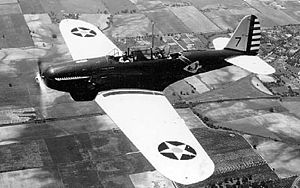PB-2A
| P-30 (PB-2) | |
|---|---|
 |
|
| Consolidated P-30 | |
| Role | Fighter aircraft |
| Manufacturer | Consolidated Aircraft |
| First flight | January 1934 |
| Status | Retired |
| Primary user | United States Army Air Corps |
| Number built | 60 |
The Consolidated P-30 (PB-2) was a 1930s United States two-seat fighter aircraft. An attack version called the A-11 was also built, along with two Y1P-25 prototypes and YP-27, Y1P-28, and XP-33 proposals. The P-30 is significant for being the first fighter in United States Army Air Corps service to have retractable landing gear, an enclosed and heated cockpit for the pilot, and an exhaust-driven turbosupercharger for altitude operation.
In 1931, the Detroit Aircraft Corporation, parent company of the Lockheed Aircraft Company built a two-seat single-engined fighter aircraft based on the Lockheed Altair high-speed transport as a private venture. The prototype, the Detroit-Lockheed XP-900, flew in September 1931 and was purchased by the United States Army Air Corps as the Lockheed YP-24. Its performance was impressive, being faster than any fighter then in service with the Air Corps, and an order for five Y1P-24 fighters and four Y1A-9 attack aircraft was placed for the new aircraft, despite the loss of the prototype on 19 October 1931. The Detroit Aircraft Corporation went into bankruptcy eight days later, however, leading to the cancellation of the contract.
When the Detroit Aircraft Corporation failed, the chief designer of the YP-24, Robert J. Woods was hired by Consolidated Aircraft. Woods continued to develop the YP-24, the design becoming the Consolidated Model 25, with all-metal wings replacing the wooden wings of the YP-24 and a larger tail. The Army Air Corps ordered two prototypes as the Y1P-25 in March 1932, to be powered by a Curtiss V-1570-27, fitted with a turbo-supercharger on the port side of the forward fuselage. The order for the second prototype was quickly changed to a Y1A-11 attack aircraft, omitting the supercharger.
First to fly was the Y1P-25, which was delivered to the Air Corps on 9 December 1932. It demonstrated promising performance, reaching a speed of 247 miles per hour (398 km/h) at 15,000 feet (4,600 m), but was destroyed in a crash on 13 January 1933, killing its pilot, Hugh M. Elmendorf (whose name was later given to Elmendorf Air Base in Alaska).
...
Wikipedia
